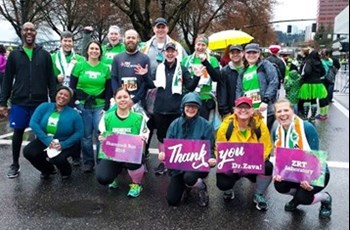
On March 13th, a number of ZRT employees, together with friends and family, participated in Portland's annual Shamrock Run - the largest walking and running event in Oregon.
Our decision to participate in this event was motivated by ZRT's mission to promote wellness. After all, the concept of wellness encompasses both physical and social dimensions. So what better way to spend a fresh, beautiful, albeit rainy Pacific Northwest morning than walking or running with your colleagues, friends, and family?
How does walking and running contribute to wellness?
We all know that exercise is good for you. But what does that really mean? Exercise aids weight loss and disease prevention, boosts energy levels, helps optimize brain health, reduces risks of all-cause mortality, and increases longevity [1;2]. What really happens inside your body during and after periods of intense physical activity?
Stress can be good
In a nutshell, exercise is perceived by your body as stress (the good kind) that prompts a physiological response. Accompanied by profound dopamine, serotonin, and endorphin production, the "feel good" chemicals, physical exercise initiates a cascade of chemical reactions in the endocrine and nervous systems. The stress response starts with the activation of the hypothalamic-pituitary-adrenal (HPA) axis, and results in the release of cortisol from the adrenal glands. With prolonged psychological stress, which is a bad kind of stress, cortisol levels rise but remain elevated, potentially leading to deleterious effects such as hypertension, hyperglycemia, and depression. However, after exercise cortisol is inactivated and levels return to normal [3;4]. So in a way, by subjecting yourself to the stress of exercise, you teach your body to respond to stress in a healthy way. The mechanism of cortisol inactivation is crucial because it protects trained individuals from the above-mentioned detrimental health consequences [5].
"Athlete's heart"
Exercise aids weight loss and disease prevention, boosts energy levels, helps optimize brain health, reduces risks of all-cause mortality, and increases longevity [1;2]. |
Physical activity is good for your muscles. One such muscle in particular is the heart. The cardiovascular benefits of exercise are well documented. Regular physical activity improves the cardio-metabolic profile by decreasing the levels of blood lipids, triglycerides, LDL, and glucose and normalizing insulin and hemoglobin A1c levels. Additionally, the heart undergoes beneficial structural, functional, and electrical changes that become increasingly important in slowing cardiovascular function decline in aging [6].
Healthy bones
Accumulation of healthy bone mass can be achieved by sufficient calcium and vitamin D intake, exercise, and adjusted caloric intake from the onset of puberty. As we age, women in particular are prone to a pronounced loss of bone density. The presence of estradiol and growth hormone impede rapid bone loss. After menopause, however, estradiol and growth hormone levels decrease, making women susceptible to rapid and progressive bone loss. Recent studies show that estrogen replacement, calcium intake, and exercise together are protective against bone loss in postmenopausal women [7]. Additionally, remember that release of cortisol in response to stress? Interestingly, with physical stress (e.g., exercise), the production of cortisol is accompanied by the release of growth hormone, whereas psychological stress rarely is. Growth hormone in turn helps maintain bone density and positively affects bone health.
Social dimension
A recent study in Psychological Science discussed a mechanism underlying the link between positive emotions and physical health. What the group discovered is that positive social connections and positive emotions are intimately linked, and together they not only drive physical health, but influence each other in a self-sustaining manner [8]. Mechanistically, social connections increase positive emotions by increasing vagal tone, the part of our nervous system that helps regulate emotions, perception, and cognition (in addition to many other things). In other words, vagal tone is the link between positive emotions and physical health. This is how meaningful social connectivity provides essential psychological nutrients that drive well-being.
There you have it – happy hearts, strong bones, and healthy stress responses fulfilling our physical and social aspects of wellness together with colleagues, friends and family. What a lovely way to spend a Sunday morning.
More ZRT Blogs
- Blog: 7 Tips to Making Your Own Blue Zone
- Blog: How Hormones are Key to the Top 10 New Year's Resolutions
Reference List
[1] Schnohr P, O'Keefe JH, Marott JL, Lange P, Jensen GB: Dose of jogging and long-term mortality: the Copenhagen City Heart Study. J Am Coll Cardiol 2015;65:411-419.
[2] Sallam N, Laher I: Exercise Modulates Oxidative Stress and Inflammation in Aging and Cardiovascular Diseases. Oxid Med Cell Longev 2016;2016:7239639.
[3] Gouarne C, Groussard C, Gratas-Delamarche A, Delamarche P, Duclos M: Overnight urinary cortisol and cortisone add new insights into adaptation to training. Med Sci Sports Exerc 2005;37:1157-1167.
[4] Labsy Z, Prieur F, Le PB, Do MC, Gagey O, Lasne F, Collomp K: The diurnal patterns of cortisol and dehydroepiandrosterone in relation to intense aerobic exercise in recreationally trained soccer players. Stress 2013;16:261-265.
[5] Heijnen S, Hommel B, Kibele A, Colzato LS: Neuromodulation of Aerobic Exercise-A Review. Front Psychol 2015;6:1890.
[6] Wilson MG, Ellison GM, Cable NT: Basic science behind the cardiovascular benefits of exercise. Heart 2015;101:758-765.
[7] Borer KT: Physical activity in the prevention and amelioration of osteoporosis in women : interaction of mechanical, hormonal and dietary factors. Sports Med 2005;35:779-830.
[8] Kok BE, Coffey KA, Cohn MA, Catalino LI, Vacharkulksemsuk T, Algoe SB, Brantley M, Fredrickson BL: How positive emotions build physical health: perceived positive social connections account for the upward spiral between positive emotions and vagal tone. Psychol Sci 2013;24:1123-1132.
